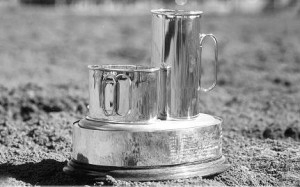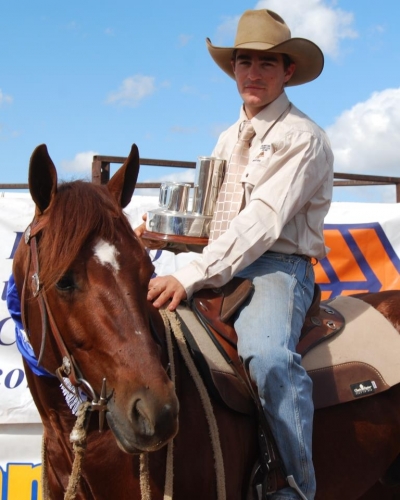Horsezone News
Cloncurry Stockman's Challenge
 |
|
The Reg Brown Memorial Cup
|
 |
| 2011 Cloncurry Stockman's Challenge Winners, Hugh Miles & Millionnic Chic (IMP) |
The Cloncurry Stockman’s Challenge, regarded as one of Australia's greatest horse events, is being held from Thursday 12 July to Sunday 15 July at the Cloncurry Recreation Grounds.
Listed as one of the “150 Must Do Things” on Queensland’s 150th Anniversary Celebration Calendar, the Curry Challenge (as it is fondly known) is an elite and prestigious event, drawing competitors from all states for a fierce and thrilling competition.
Horsezone is proud to be on board this year as a sponsor of the Cloncurry Stockman's Challenge.
The competition requires competitors to complete two demonstrations; the first is the ‘dry’ section. Competitors and their horses are to complete a pattern before two judges. In this pattern are manoeuvres such as flying changes, roll backs, spins and stops. This pattern is designed to display the horse’s athleticism, ability and trainability whilst exhibiting the rider’s horsemanship. The second demonstration is again before two judges, this time the horse and rider combination is required to work cattle in a manner similar to a Campdraft course. The grand final will be on Saturday afternoon, subsequently after the grand parade and presentation of the finalists. The Stockman’s Challenge will carry a first prize minimum, of $10,000. As well as this pinnacle event, competitors will also be competing for various prizes in several other events.
click here for copies of the dry work patterns and score sheets.
About the Cloncurry Stockman's Challenge
It might seem somewhat ironical that the Stockman’s Challenge was created as a memorial for Reg Brown. Yet, that one small idea – that one small act of generosity – has created a new benchmark in the Australian Horse Industry.
Reg Brown was a highly respected grazier from Nonda Downs near Julia Creek. He was a dedicated stud breeder and his sheep, cattle and horses attracted wide success and admiration across Queensland. He was also famous as the owner of Macdougal, winner of the 1959 Melbourne Cup, the man who brought one of Australia’s greatest icons back to the bush. When Reg passed away in 1983 his devoted daugther Heather, a keen horsewoman, decided to create a fitting memorial for her father. This was the first seed of the Stockman’s Challenge.
Peter Abdy, a neighbour at the time, and Heather were mustering cattle together, when she mentioned her idea to him. She later asked legendary bush artist Hugh Sawrey to create the famous hat and spurs logo for her – and the distinctive image was created.
Peter – who was deeply passionate about all things Australian – was completely captivated by the idea. He convinced the Cloncurry Show Committee to host the inaugural event, and Heather designed and commissioned Hardy Brothers to create the Reg Brown Memorial Cup. The original solid silver quart pot – now valued around $20,000 – has become something of a national bush icon.
It was a point of contention that the famous cattle town of Cloncurry did not get the Stockman’s Hall of Fame: it went to Longreach, a wool-growing town instead. But the Stockman’s Challenge would ultimately become something equally important: a living tribute to the Australian horseman.
The Stockman’s Challenge has become the bench mark for young performance horses in Australia: it was the beginning of a new era. The only other events of any similar stature were the Warwick Gold Cup and the NCHA Futurity. There were no other aged events with set patterns: The Stock Horse Futurities, Widgee Futurity, the Rocky Rush and the Maiden Series would all eventually follow the lead of the Stockman’s Challenge.
In 20 years, the challenge achieved remarkable things for the Australian horse industry. It brought campdrafters, reiners and cutters together. It taught the industry that things that unite are far greater then things that divide. People began to put prejudices aside and started sharing skills, which gave us the horse industry a greater resource of knowledge. The results now speak for themselves.
The Challenge has put its brand on genetics - better horses are being produced sooner. Originally, a horse was still considered young at seven or eight years old and good mares not bred until 15 or 16 if at all. A stallion was usually 20 years old before it was known if his progeny were any good. The Challenge has changed all that.
Today, we are seeing great runs being made by horses that are still only four years old – and they can do this because of improved genetics – and improved training technique.
Quick Link
- Visit the Cloncurry Stockman's Challenge website for more information and photos
-
'Like' the Cloncurry Stockman's Challenge Facebook page
News Search
Categories
- General
- Event Results
- Stallionzone
- Sponsored Shows
- Clubs
- Health
- Feature Horses
- Competitions
- Five Minutes With Horsezone
- Young Riders
- Reviews
- Training and Clinics
- Postcards from the saddle
- 2014 Equitana by HORSE FIRST
- 2013 Equitana
- 2012 Equitana
- 2012 London
- 2011 Equitana
- 2011 Queensland Floods
- 2010 WEG
